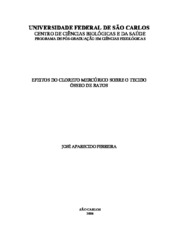Efeitos do cloreto mercúrico sobre o tecido ósseo de ratos
Resumo
The mercury is used in the industry, medicine, agriculture and other fields. However, little is known about its involvement with the bone metabolism. The aim of this study was to evaluate the physical, biochemical and biomechanical bone parameters in adult rats contaminated with mercuric chloride during the development phase. The animals were separated as control group: 10 male rats treated with saline 0.9% (0,1 ml/100g BW) and contaminated group: 8 male rats treated with mercuric chloride (2.5 mg/Kg BW). The animals were treated during 60 days, 5 days/week, by stomacal gavage. The body weight, femoral length and diaphysis thickness were measured. The mechanical properties (maximum and failure forces, stiffness and yield) of femurs were evaluated by the three-point bending test using the universal machine Instron model 4444. The bone volume was estimated by the Archimedes Principle. The wet and ash weight were also determined. The body weight, length and minor diameter of
the femurs were not different between the groups; however the major diameter increased in contaminated group (p=0.0002). It was observed an increase (p=0.0044) of bone volume and a decrease of the bone mineral density (p=0.0009) and of the percentage of mineral material
(p=0.0001) of the femurs of the contaminated group. The bone response to biomechanical test was similar in both groups. The rat contamination with mercuric chloride in the dose of 2.5 mg/Kg BW caused small alteration in the development of bones, as observed by the biometrical and biophysical parameters analyzed. However these alterations were not enough to induce modification of the biomechanical and biochemical parameters.
